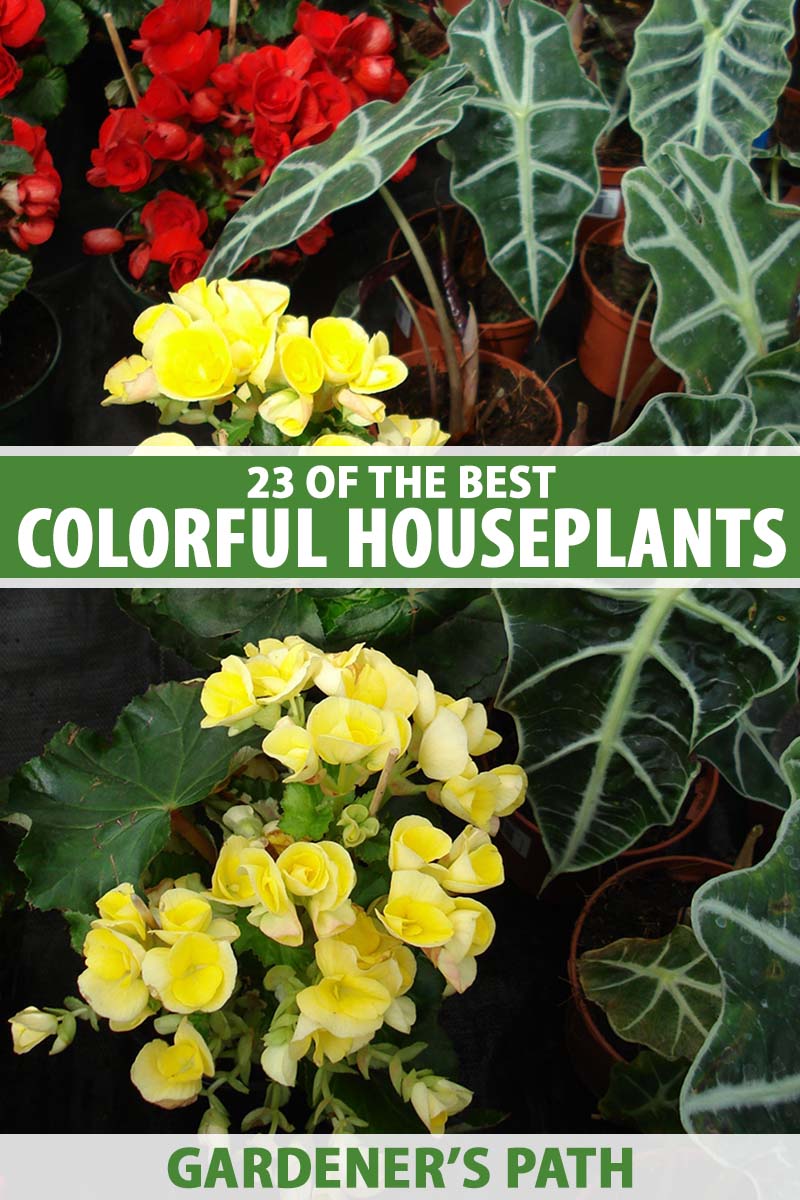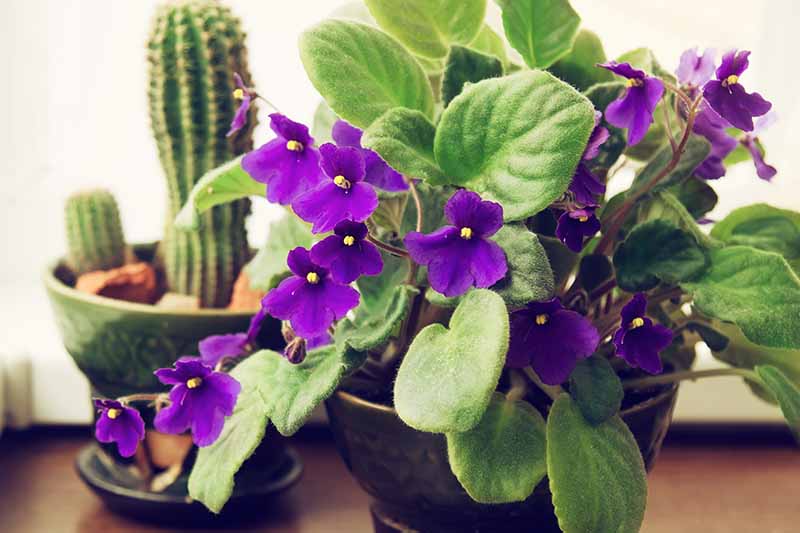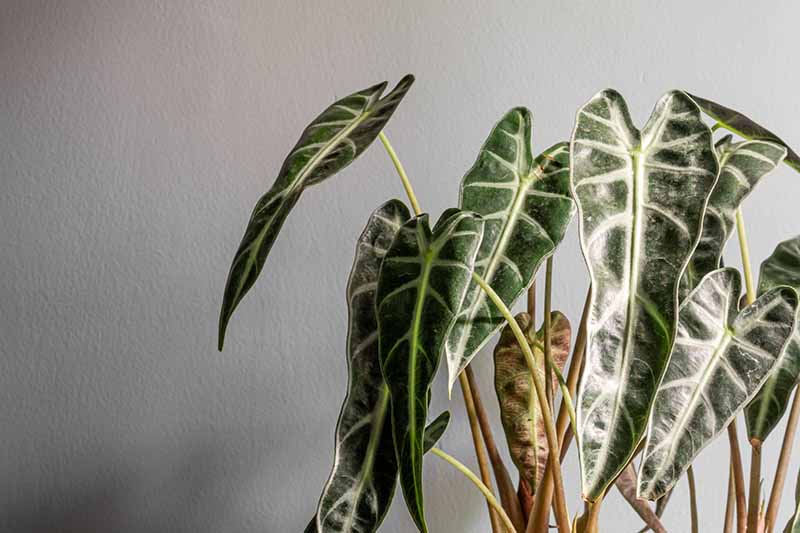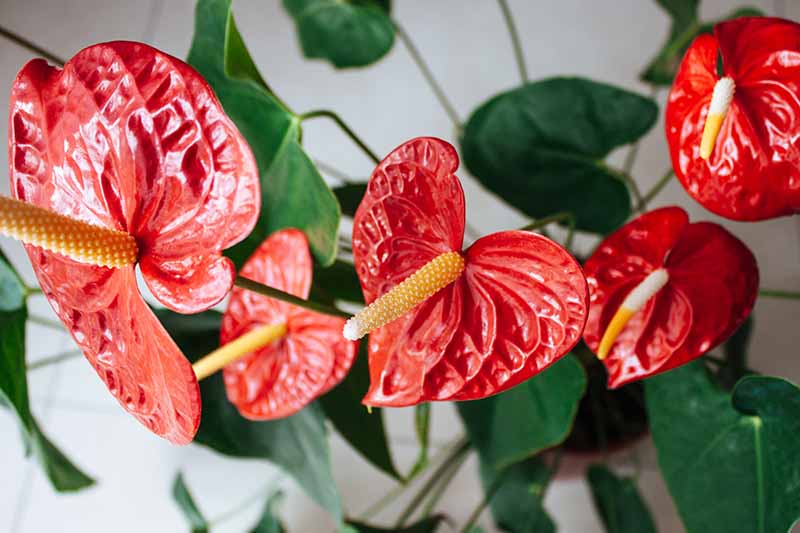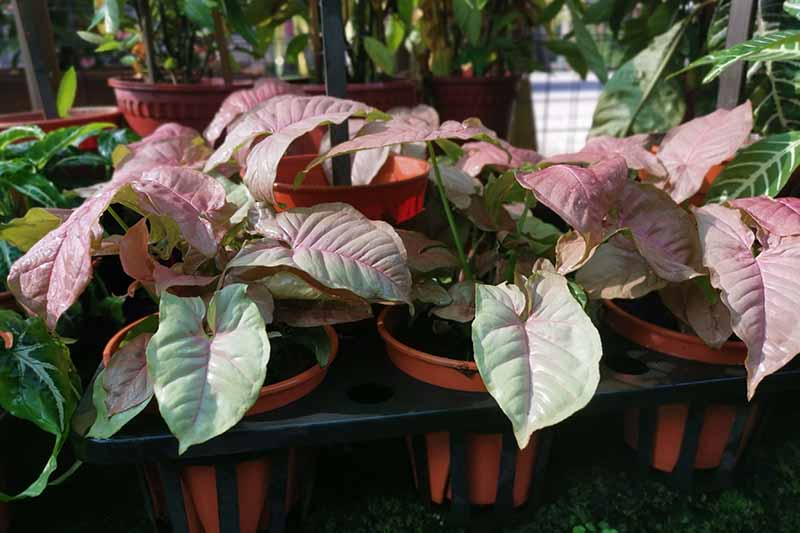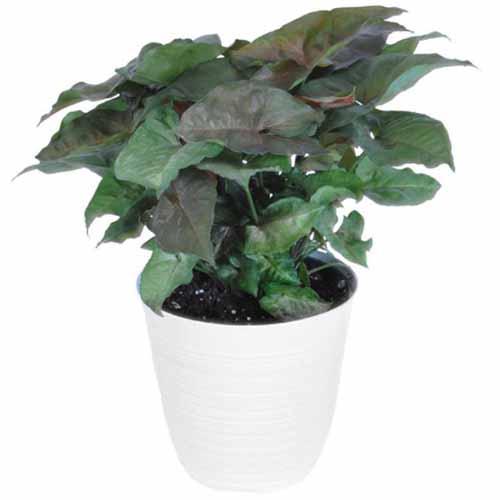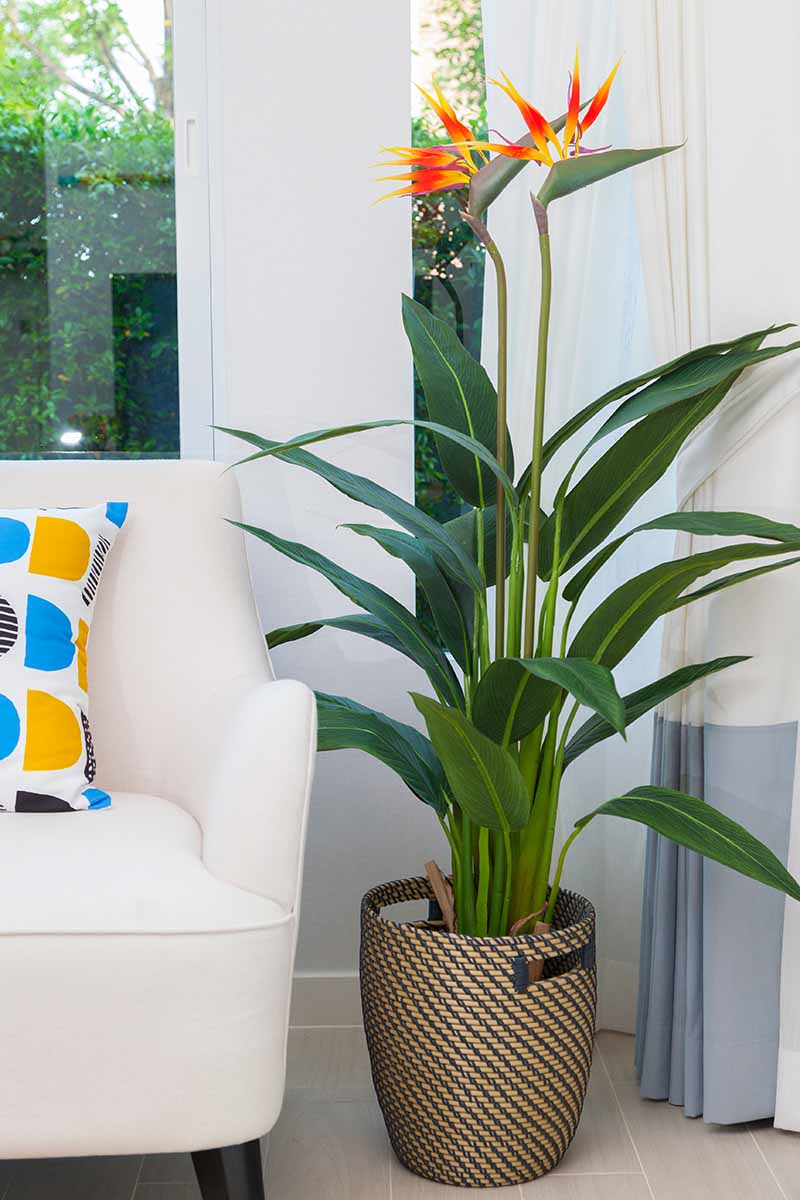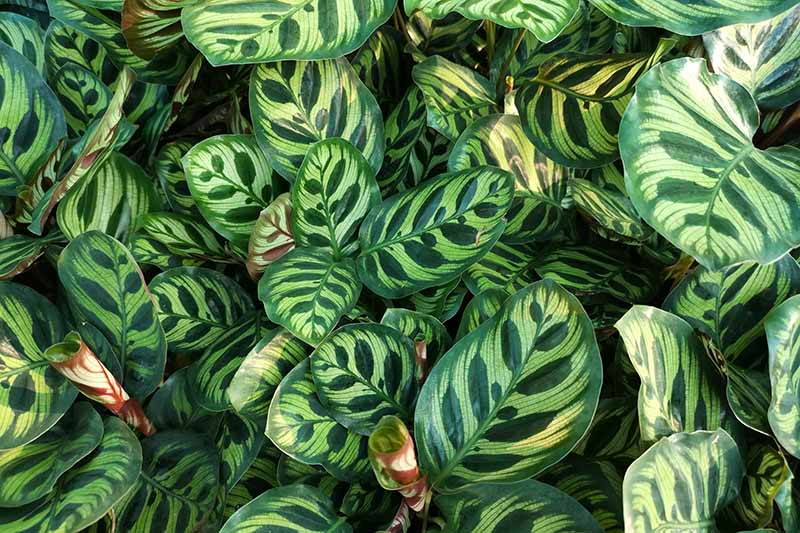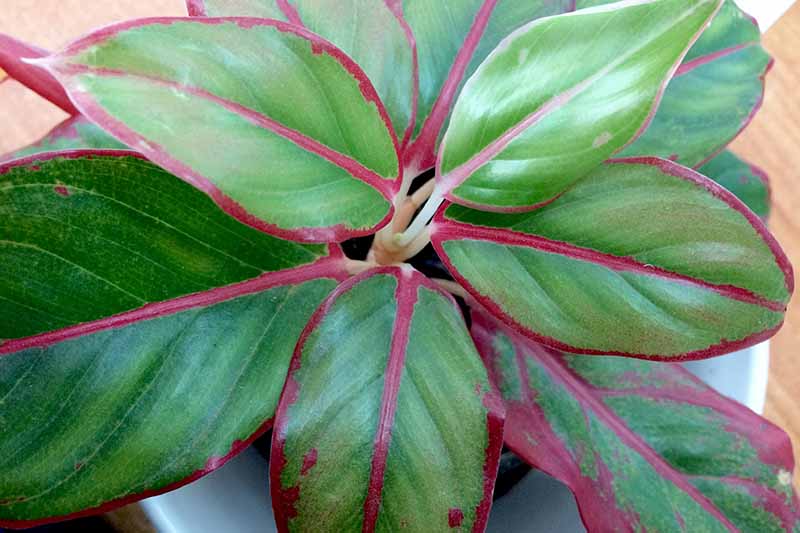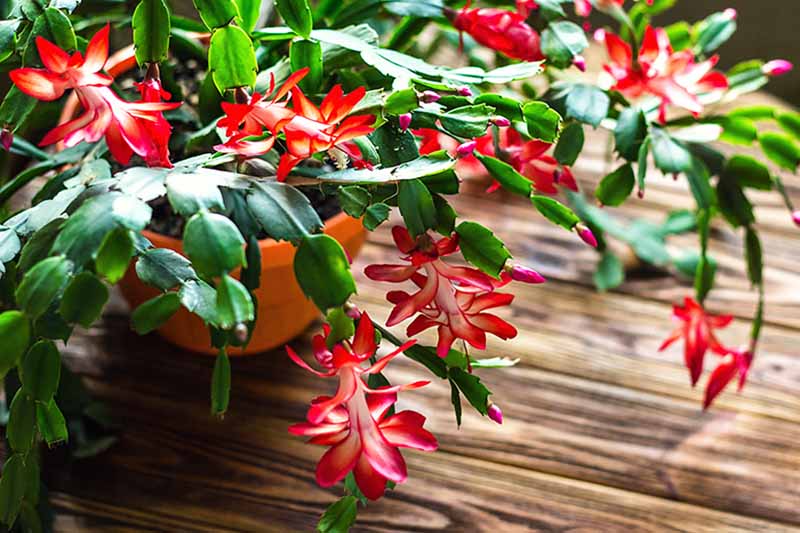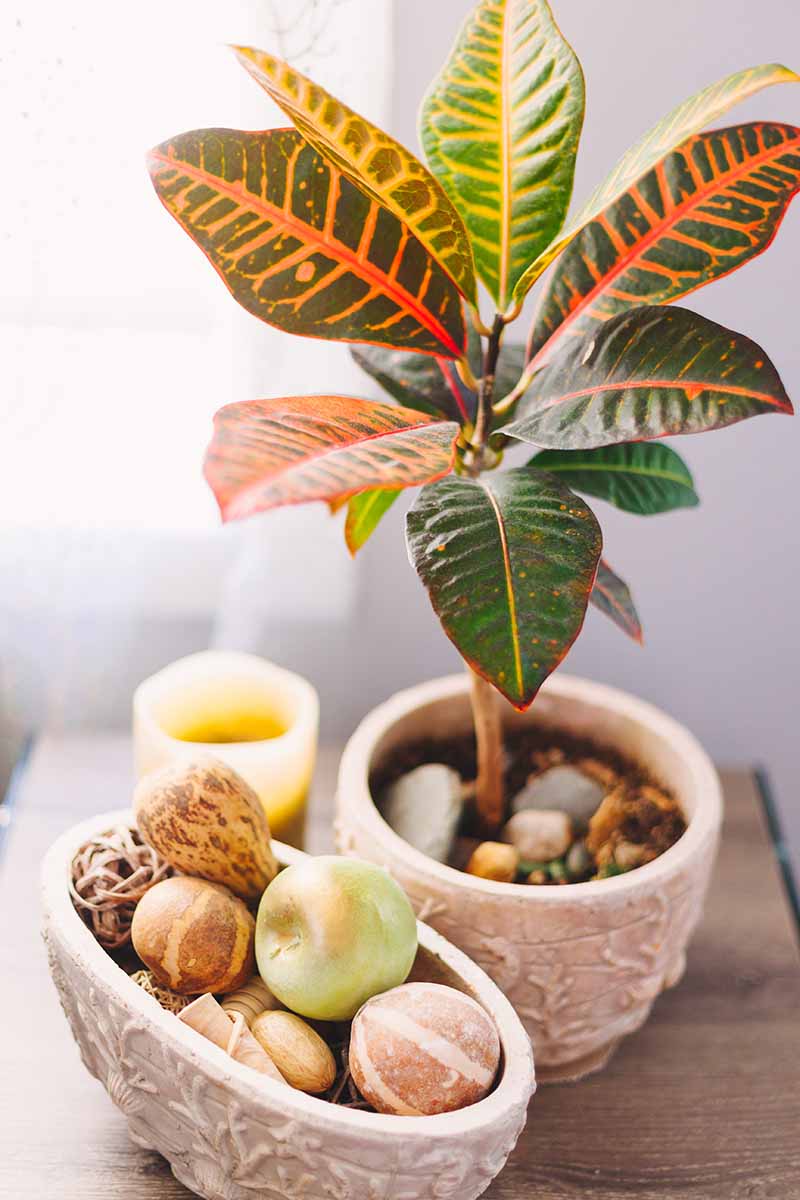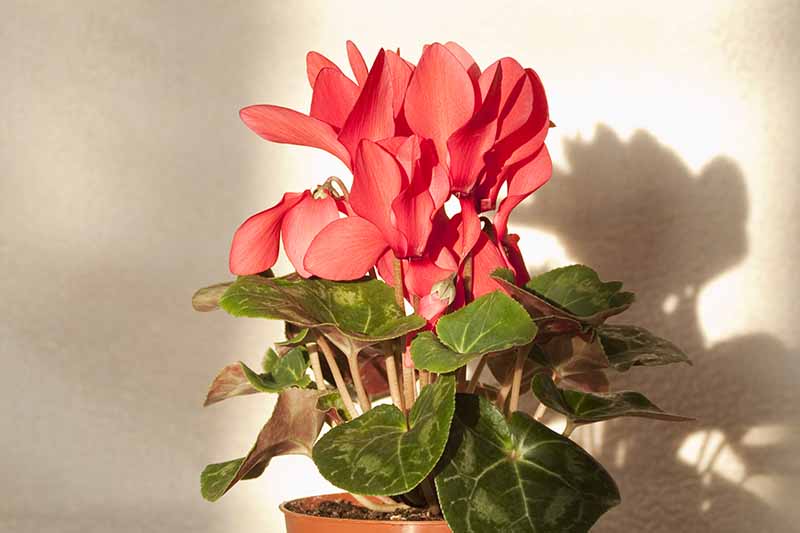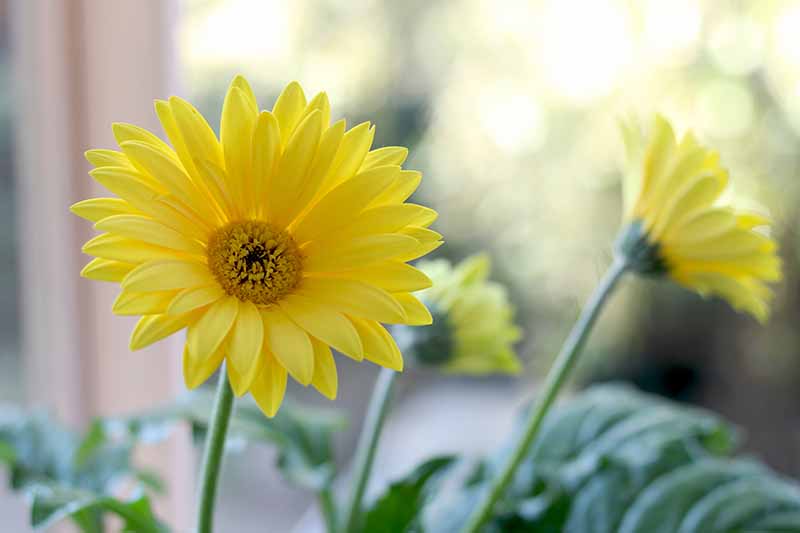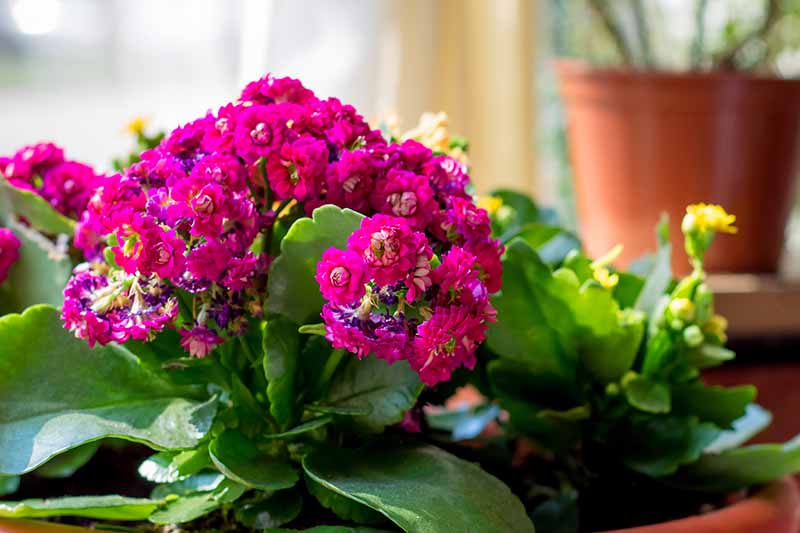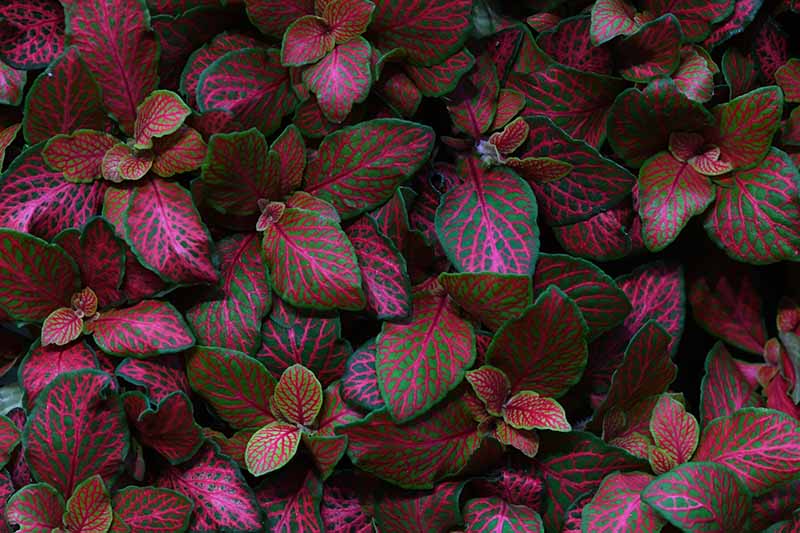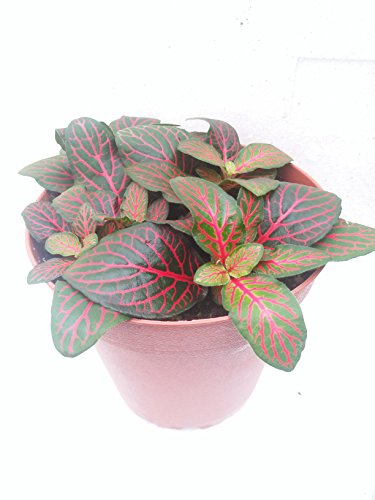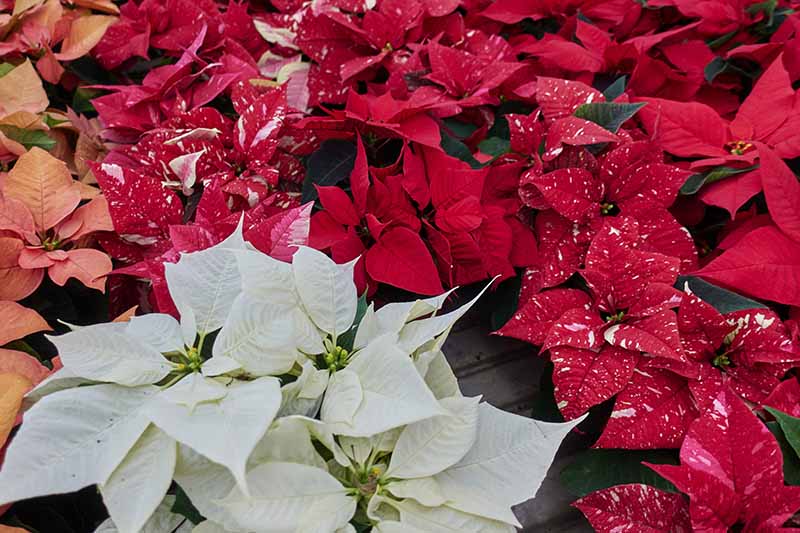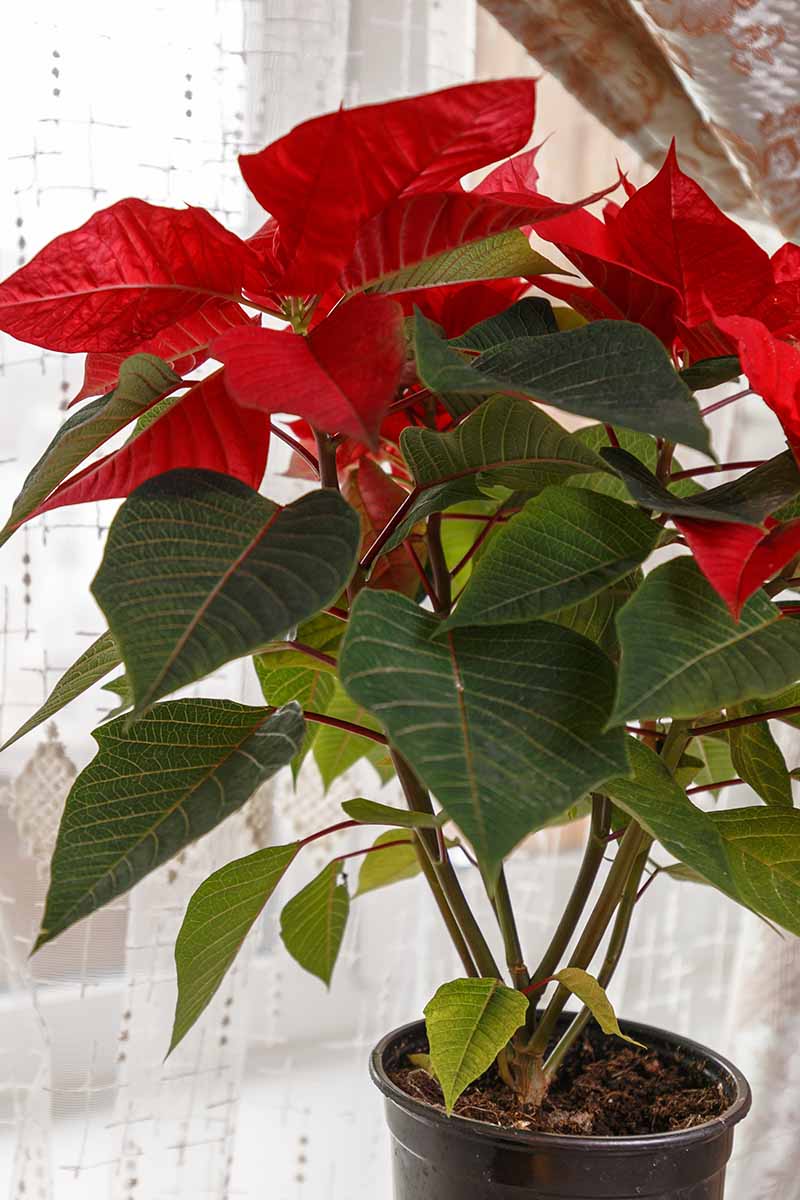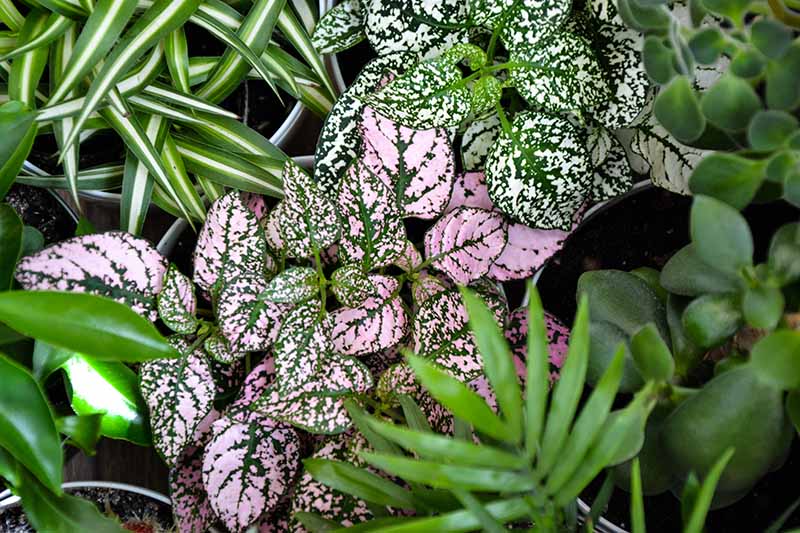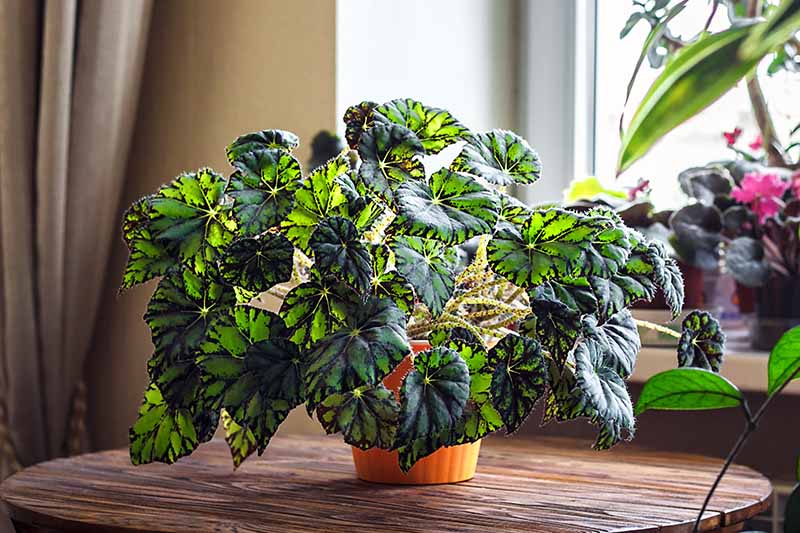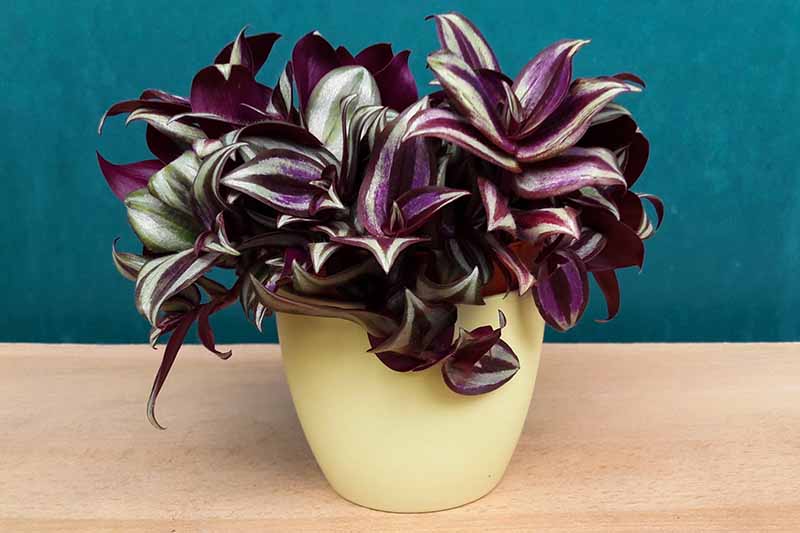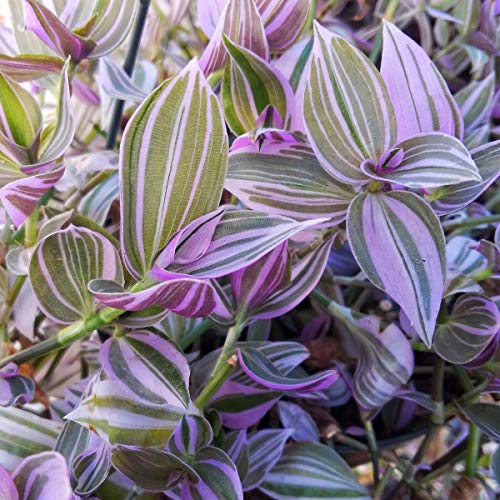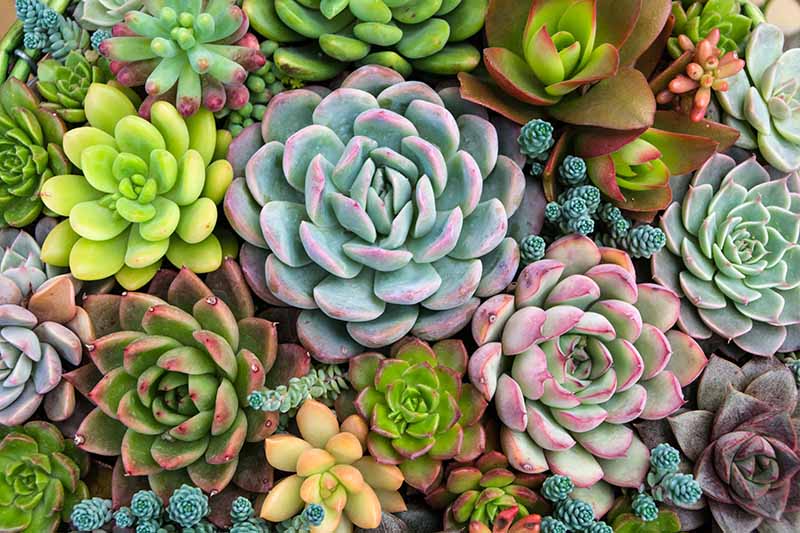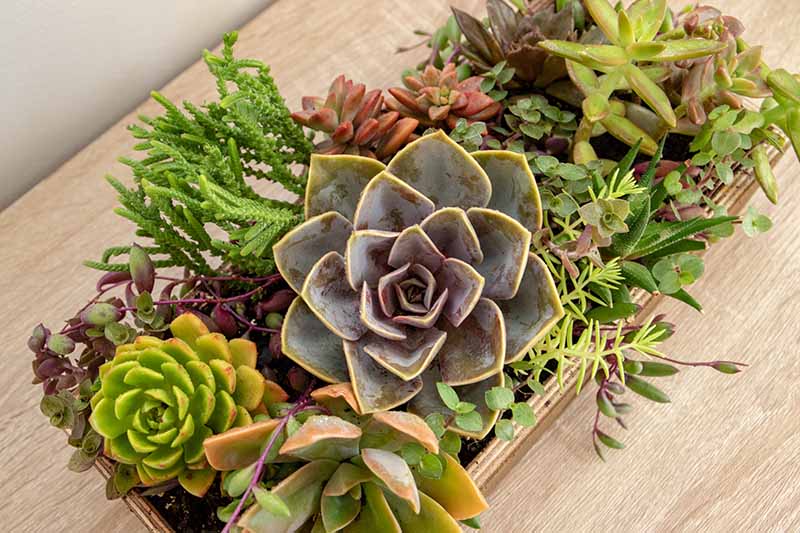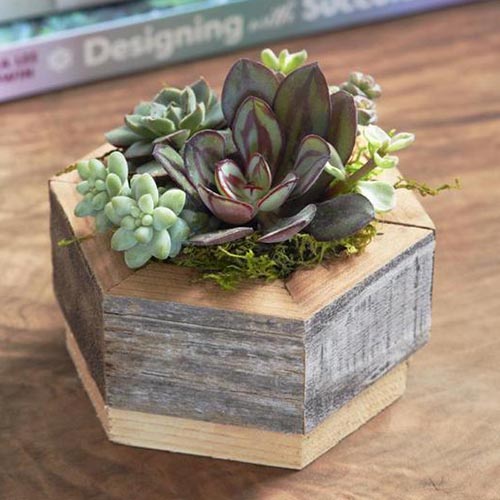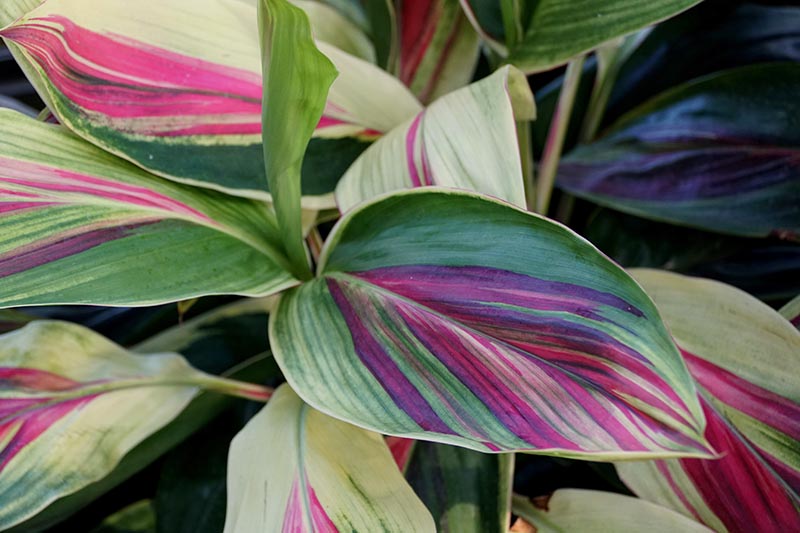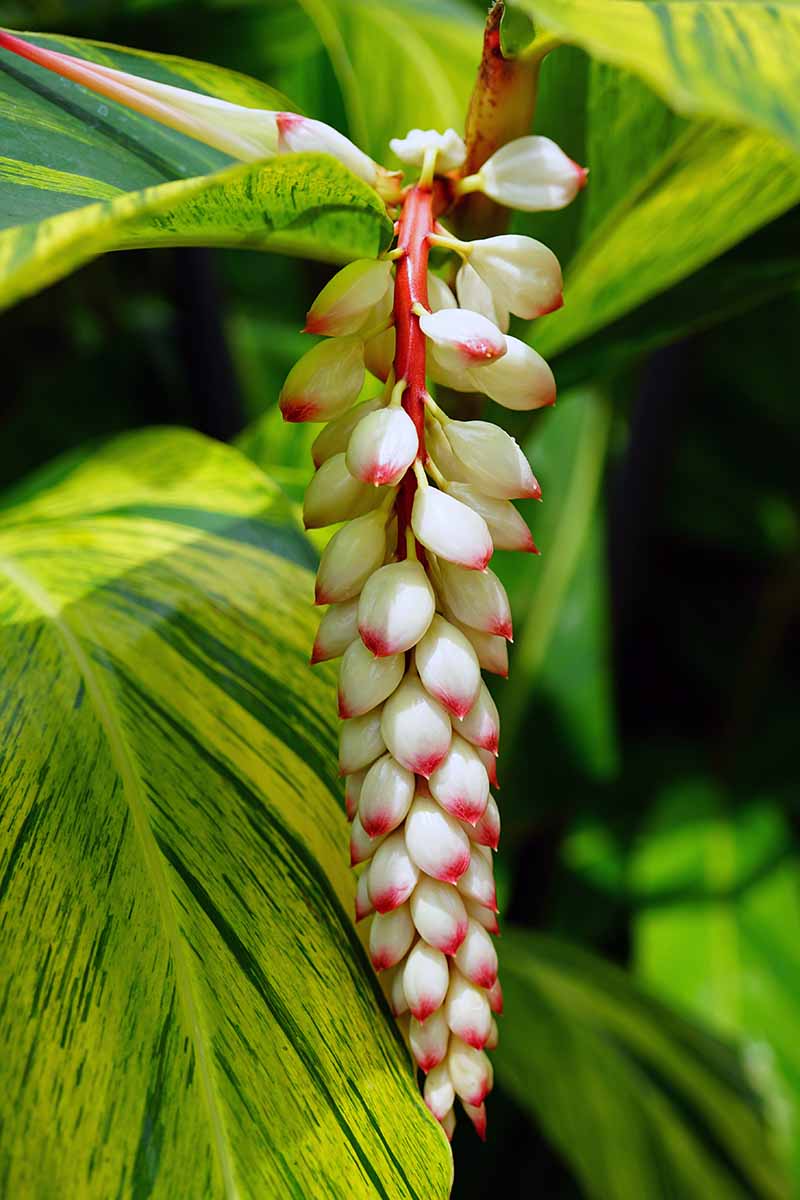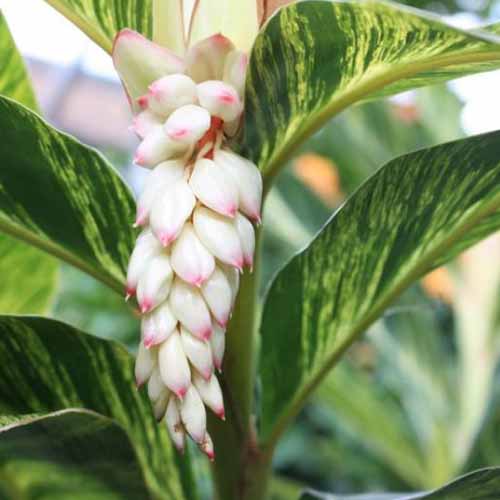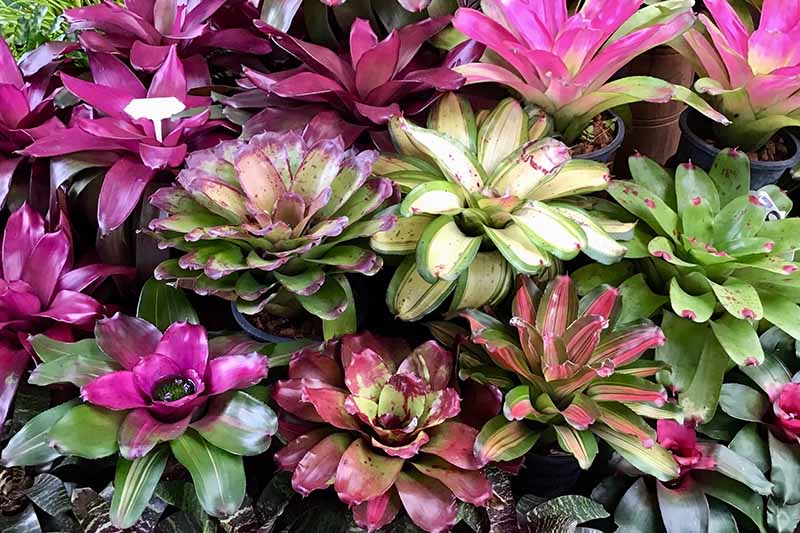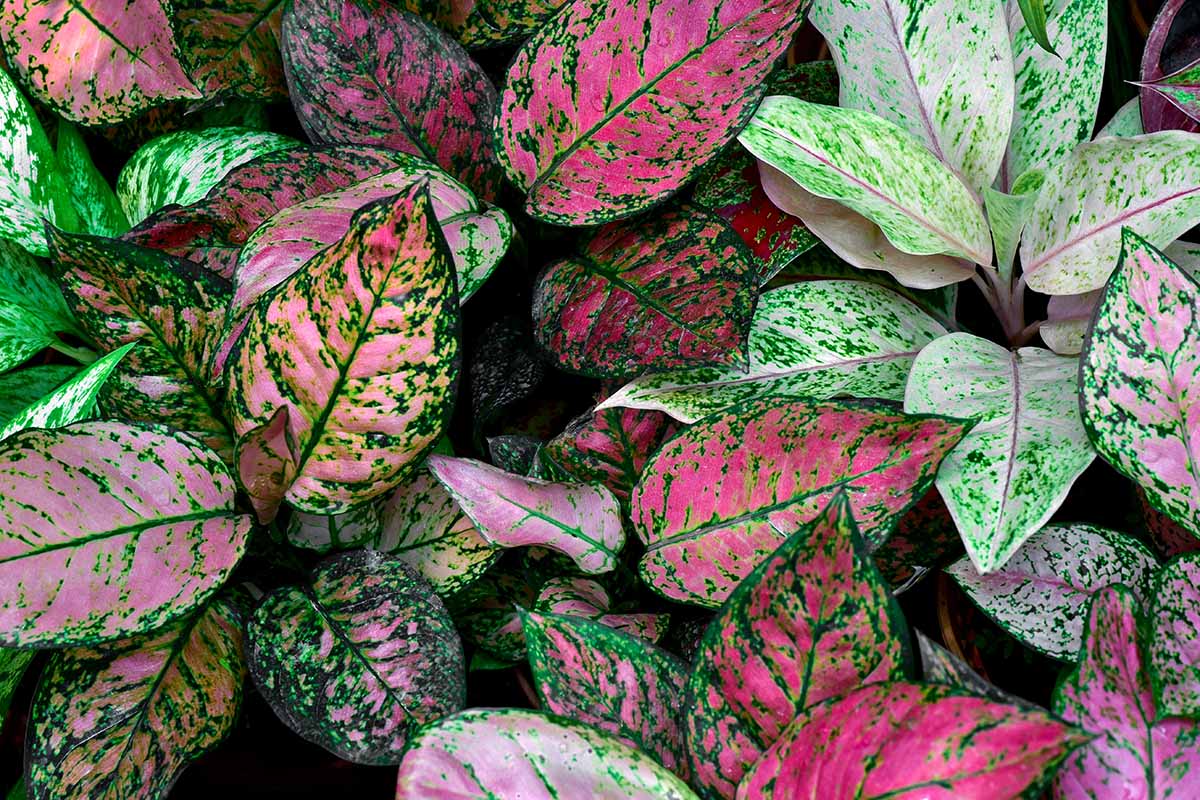A cheery houseplant (or three) might be just the companion you need for your winter rejuvenation. And many houseplants will last for years if you provide them with the proper care. We link to vendors to help you find relevant products. If you buy from one of our links, we may earn a commission. I’ve whittled down a list of 23 of my favorite houseplants that add a splash of color – and I bet you’ll find just the one to warm up your home through the colder months. Some of these may be familiar, while others may be new to you. I’ll briefly introduce each of them and offer buying tips for some of my favorite varieties, and provide some information on caring for each of these vibrant houseplants.
1. African Violet
I bet you’re familiar with this old school houseplant. With its fuzzy leaves and dainty little flowers, African violet, Saintpaulia, is unassuming and gently brightens up a home. Also known as kris plant, black shield, elephant ear, or African mask, this houseplant looks as stunning as a sculpture. Maybe these flowers don’t seem exotic enough for you? Perhaps it’s time to reconsider. These African natives are available with flowers that are double-blossomed, fringed, or ruffled, and some cultivars have variegated leaves. Their low-growing forms make them great houseplants for small spaces – just remember to water them regularly and provide them with bright, indirect sunlight. African Violet You can find sets of four assorted African violet plants in four-inch pots available via Walmart. Find tips on growing and caring for African violets here.
2. Alocasia
Going by many different common names, plants in the Alocasia genus will certainly bring an air of drama to your living room. Alocasia’s glossy green leaves have large white veins on the topside, while the underside is a deep purple hue. Alocasia can create a fabulous focal point in a home with an eclectic decorating vibe. Alocasia ‘Black Velvet’ These stunners are available as live plants in one-gallon pots from Fast Growing Trees.
3. Anthurium
Also known as flamingo flower, laceleaf, and tailflower, houseplants in the Anthurium genus offer a bright splash of color with their long-lasting red or pink flowers. Not only are anthurium flowers brightly colored, they are glossy and heart shaped, and will certainly add to a romantic or glamorous decorating style. With its red and green coloring, this houseplant could make a pleasing addition to your holiday decorating scheme. This plant will thrive in your home with medium to bright indirect light, as long as you keep on top of watering – it does not like to dry out. With proper care, anthurium will grow to one and a half feet tall and a foot wide. ‘Tickled Pink’ Live ‘Tickled Pink’ anthurium plants are available from Burpee. Read more about growing anthurium plants here.
4. Arrowhead Vine
For those who prefer a more understated approach when it comes to color, arrowhead vine (Syngonium podophyllum) offers a soft touch. Also called arrowhead plant, this houseplant’s leaves can be found in shades ranging from light green to light pink, and could be combined nicely with the often shorter-lived poinsettias found at this time of the year. Arrowhead vine will appreciate a warm, humid spot in your house, with bright, indirect sunlight. As a vining plant, as its name suggests, offer it a hanging basket to trail from or a moss pole to grow on, as its vines can reach up to six inches long. ‘Merry Maria’ The ‘Merry Maria’ cultivar has glossy-green leaves that start out pink, and is available in six-inch pots from Home Depot. Read more about growing arrowhead plants here.
5. Bird of Paradise
If you’re looking for a bright, tropical burst of color to liven up your interior when it’s cold outside, bird of paradise from the Strelitzia genus might be the houseplant for you. A taller houseplant, its flashy, beak-shaped flowers in orange, yellow, and blue are held above its lush green foliage on long green stems. Placed near a sunny window with southern exposure, bird of paradise could be used to create an indoor tropical feel. Bird of paradise should be given direct sun during the cooler months, and bright, indirect sun during the warmer months. Only allow the top inch of the soil to dry out between waterings. Orange Bird of Paradise You’ll find an orange bird of paradise plant in a three-gallon pot available for purchase at Fast Growing Trees.
6. Calathea
Calatheas may be among the decorative indoor plants you’ve encountered before that merit renewed attention. Among the different species of the Calathea genus, commonly called “prayer plants,” there are many varieties boasting beautifully patterned foliage. Calathea leaves are geometrically patterned with stripes, splotches, spots, or shading in colors that can include dark and light green with touches of red, purple, or white. Non-blooming evergreen plants like this are lovely on their own, or grouped with other houseplants in complementary colors. Called “prayer plant” because their leaves fold up at night, calatheas prefer warm, humid environments. Avoid direct sunlight, which will bleach their beautiful leaves. Instead, provide them with indirect light, and remember to keep their soil moist but not soggy. ‘Medallion’ ‘Medallion’ is a variety with leaves that look as though they have been created by a painter, and is available in six-inch pots from Fast Growing Trees.
7. Chinese Evergreen
Chinese evergreen, the common name for several species of the Aglaonema genus, is another fairly common houseplant in its green and white form. But varieties with red leaf veins and margins will surprise you – and might just knock your socks off. This is another green and red houseplant that would be well-placed among your holiday decor. Keep it around after the festivities are over, to take the edge off the post-holiday blues. Reaching about one and a half feet tall and wide, Chinese evergreen will thrive in low to bright indirect light. It should not be allowed to dry out between waterings, but is overall a low maintenance houseplant. ‘Hot Pink Valentine Wishes’ Read more about growing Chinese evergreens.
8. Christmas Cactus
Speaking of the holidays, don’t forget about the bright blooms of Christmas cactuses, members of the Schlumbergera genus. Those blooms can come in a variety of colors – white, pinks, reds, purples, and even yellows. A mid-sized decorative houseplant, Christmas cactus will provide a splash of color and texture on a desk or tabletop, or in a hanging basket. Christmas cacti are undemanding plants that will brighten your spirits in the winter months. Christmas cactus requires bright, indirect light during its growing season and should be watered when the top inch of soil is dry. To encourage blooming year after year, a special routine of cool temperatures and long nights is required. You can learn more about this flower-coaxing routine as well as general care tips for this succulent in our Christmas cactus growing guide. Christmas cacti are among the longest living houseplants, so when you choose yours, make sure you pick a flower color you love. Pink Christmas Cactus You can find plants in pink, yellow, red, or white available from Fast Growing Trees.
9. Coleus
You may be more familiar with coleus (Plectranthus scutellarioides) as an annual bedding plant, rather than a houseplant. But this vibrant tropical evergreen works well indoors, where it can live for several years, and comes in a dizzying variety of color combinations and patterns. It’s a low maintenance houseplant, and can handle a range of indirect light situations, from low to bright. Coleus should not be allowed to dry out completely, but make sure you don’t overwater it either. Its soil should be moist but not waterlogged. How about starting your coleus plants from seed? The gorgeous, bright fiery-red foliage on this variety, enticingly called ‘Inferno,’ will bring your home a splash of color – and you’ll have the pride of knowing you grew your plant from seed. ‘Inferno’ You can find four-plant bundles available from Burpee.
10. Croton
If you’re looking for a houseplant that’s as colorful as a tropical celebration, croton (Codiaeum variegatum) will be just what you’re looking for. Also called garden croton, these houseplants offer brightly mottled foliage available in a mix of green, yellow, orange, and/or red. If that’s not enough color for you, there are some rarer varieties that also include pink and purple in the mix. And the leaves come in many different shapes, so you’re practically guaranteed to find a leaf shape and color combo that will strike your fancy. Unlike most of the other plants in this list, croton does well with some direct sunlight, which will make for better leaf color. Keep croton’s soil moist but not soggy during the growing season. With proper care, this beauty can grow up to six feet tall with a five-foot spread – so make sure you are ready to provide it with some room! ‘Petra’ The ‘Petra’ cultivar has wide leaves and the tropical hues that croton is known for. You’ll find live plants of this variety in six-inch or three-gallon pots available from Fast Growing Trees.
11. Cyclamen
A member of the primrose family, cyclamen (Cyclamen species) is another compact choice that’s ideal for smaller spaces. Cyclamen is loved for the beauty of both its foliage and its flowers. Cyclamens have upswept flowers held on dainty stems above heart-shaped leaves. These flowers can be white, pink, red, or purple, and the heart-shaped leaves are often graced with silvery patterns. This charming houseplant is another good choice for a smaller space – it will only grow to about nine inches tall and wide, and will thrive in bright, indirect sunlight. Keep your cyclamen’s soil moist – except during its dormant season in the summer, when it should be watered less frequently. Latinia® Red Pick up four-inch Latinia® red cyclamen plants in packages of two or four from Home Depot. Read more about growing and caring for cyclamen houseplants here.
12. Gerbera Daisy
When a young child draws a flower, chances are the flower will look something like the gerbera daisy (Gerbera species). Gerberas are commonly found in bouquets, but can also grace your home as a live houseplant instead of a cut flower. The flowers of gerbera daisies will bring a summery cheer to your indoor space. They are available in almost every color of the rainbow and will grow to about 18 inches high, making for a good tabletop plant. Gerbera daisies need a few hours of direct sunlight every day but prefer cooler temperatures. When kept indoors, a bright eastern window will be the best location for them. Water when the top inch of soil is dry. ‘Garvinea Sweet Memories’ ‘Garvinea Sweet Memories’ is a variety with pink flowers, available as a live plant from Burpee. Find more tips on growing gerbera daisies here.
13. Kalanchoe
You may be familiar with the green-leaved variety of kalanchoe, a succulent plant featuring small white, red, pink, orange, yellow, or purple blooms. However, some varieties of kalanchoe look extremely unusual, with patterned foliage and colorful plantlets growing on their leaf margins. There are many colorful varieties of this houseplant to tempt the botanically adventurous. And if you happen to be one of those adventurous souls, kalanchoe may also interest you as a fun horticulture project. The plantlets that grow on the leaves of kalanchoes can be propagated easily. You can learn more about propagating kalanchoe in our article, propagating succulents in five easy steps. But keep in mind that these plantlets are very tiny! Gentle handling with tweezers can be helpful. Flaming Katy Flaming Katy, K. blossfeldiana, is available in a three-pack assortment of colors, including white, pink, yellow, and orange from Home Depot. Find more tips on caring for plants in the Kalanchoe genus here.
14. Nerve Plant
Appreciated for its striking foliage, nerve plant is also known as mosaic plant or simply by its genus name, Fittonia. While the webbed patterns that inspire fittonia’s common name are not nerves but rather highly contrasting leaf veins, this feature is certainly what makes nerve plant attractive. The leaves of fittonia are mesmerizing – foliage can be light or dark green with white, red, or pink veins. Fittonia will do well in a terrarium as it thrives in a humid environment. A grouping of these brightly-colored, low-growing plants nestled around a taller houseplant with striking flowers like anthurium would create a strong visual impact for a holiday display. Fittonia prefers low to bright, indirect light, should be kept moist, and thrives with an additional source of humidity, such as a humidifier or misting. Or set the plant on a saucer full of pebbles with water in it, to provide the moist conditions these plants thrive on. Fittonia wilts easily but can usually be readily revived by increasing humidity or watering. Red-Veined Nerve Plant
15. Orchid
Orchids, members of the Orchidaceae family, have an undeserved reputation for being difficult houseplants – probably because doting owners provide them with a little too much care. With their gorgeous blossoms, orchids can be a stunning part of your living decor. Orchid flowers come in a wide array of sizes and a dazzling spectrum of colors. You can find orchid blossoms in essentially any color you’re looking for, including delicate whites, brooding blacks, or showy pinks. There are many different types of orchids, and their care will vary. Be sure to look up your specific species so that you can supply it with appropriate light and water. As an added bonus, many varieties of orchid have blossoms that are not only beautiful, but also delightfully fragrant. Purple Orchid If you’re in the market for an orchid to add to your home decor, you can find pink, purple, salmon, white, and yellow varieties available from Fast Growing Trees. Read more about growing orchids here.
16. Poinsettia
Often treated as disposable holiday decorations, poinsettias (Euphorbia pulcherrima) can be kept on as houseplants that will provide a yearly display of bright color if given the right care. Beyond the standard red, poinsettias can also be found in hues such as white, pink, purple, orange, yellow, or salmon. Variegated poinsettias offer even more choice. The poinsettia’s color comes not from its flowers but from bracts – colorful, modified leaves. To get your plant to produce these colorful leaves each year, you’ll have to let it go through a multi-week period of rest with long nights and cooler temperatures, followed by a pre-bloom season of bright sunlight. These plants originate in dry forests in Mexico and Guatamala, so they don’t need as much water as many of the tropical houseplants that you may be familiar with. Remember to let your poinsettias dry out a bit between waterings. If your poinsettia comes with its pot wrapped in foil or plastic, remove this or poke holes in the bottom so it doesn’t stand in water. Place your poinsettia near a bright window so it gets plenty of indirect sunlight. And make sure to keep it away from drafts – poinsettias prefer steady, warm temperatures between 65 to 75°F. Poinsettias may be a bit fussy to keep as long-term houseplants, but their showy bracts are worth the trouble. Red Poinsettia You can find a red poinsettia in a one-and-a-half-gallon pot wrapped in decorative green foil available from Home Depot. Read more about growing and caring for poinsettia plants here.
17. Polka Dot Plant
Polka dot plant (Hypoestes phyllostachya) is another one you’ll love for its foliage. It has similar colors and patterns to fittonia, but grows taller and has larger leaves. The brightly colored leaves of the polka dot plant are mottled white or pink with green veins. This houseplant would brighten up a corner or add texture when arranged in a grouping with some flowering specimens. It grows to one to two feet tall with a one-foot spread and prefers high humidity. Don’t let it dry out entirely between waterings, but make sure it doesn’t stand in water either. Regular misting will help it with its humidity needs. Make sure to provide it with medium to bright indirect light. Pink Polka Dot Plant If pink is the shade that brightens your days, you can find plants in four-inch pots available from Home Depot.
18. Rex Begonia
Like alocasia, rex begonias (Begonia rex cultorum) are all about dramatic foliage. Also known as painted-leaf, fancy-leaf, or king begonias, these plants are attention grabbers. Related to the more mild-mannered wax begonia, rex begonias have strikingly patterned foliage, ranging from splotches to spirals, in mixes of silver, greens, reds, pinks, purples, and black. These houseplants are fairly demanding. They don’t like wet feet, but require a humid environment, so misting with a spray bottle will be an important part of your care routine. Make sure to give your rex begonias bright but indirect sunlight. Rex Begonia
19. Spiderwort
Spiderwort, a member of the Tradescantia genus, is one of my favorite houseplants, period. It’s a no muss, no fuss option that’s elegant and so easy to propagate from cuttings. It’s also known as inch plant. Its trailing foliage comes in various color combos, including solid green, solid dark purple, striped white and green, striped green and purple – or, my favorite, striped green and lilac. Spiderwort is frequently found in hanging baskets, but you can also feature this fast-growing plant in smaller, decorative tabletop containers. Let the top inch of the soil dry between waterings. Spiderwort will thrive in a variety of indoor light conditions, from medium to bright indirect sunlight. Green and Lilac Spiderwort Learn more about growing and caring for spiderwort plants here.
20. Succulents
While the term succulent does not refer to a specific species, genus, or family, these plants are often sold under this term without much further identification. But that doesn’t mean we should pass them up! Succulents come in a fascinating variety of colors, shapes, and sizes. Some even have beautiful patterns on their leaves. They are available in in gorgeous pastels, muted reds, bright lime greens, and many other hues. Some of the genera that are commonly sold under the more generic term “succulents” include Sempervivum, Echeveria, and Lithops. You can learn more about these fascinating plants in our article about 11 easy to care for exotic succulents. Most succulents require full sun, and will do well in bright, southern-facing windows. They have lower water needs than the average houseplant, so are generally lower maintenance. But that doesn’t mean you can forget about them altogether. To learn more about how to meet the particular needs of these xerophytes, see our growing guide. Succulents work particularly well for small spaces – you can fill a planter with several different species, creating a miniature botanical garden in your living room. And if you’re interested in a planter full of succulents that’s ready to beautify your living space, Succulent Gardens has some delightful options. Succulent Hexagonal Planter This succulent hexagon planter, measuring four inches across and made of reclaimed wood, is filled with an assortment of succulents – and is available to purchase from Succulent Gardens.
21. Ti Plant
By looking at it, you’d never guess which veggie this tropical broadleaf evergreen shrub is related to. Surprisingly, Cordyline fruticosa, most commonly called “Ti plant” or just “Ti,” is in the same family as… asparagus! Native to Southeast Asia, Ti has widely naturalized in Polynesia, and is found in Hawaii, New Zealand, and Easter Island, and other tropical and sub-tropical locations. In the wild, Ti grows into a small tree or shrub, reaching about 10 feet in height, but when grown indoors usually grows no more than three to six feet tall. Ti also goes by the names of “cabbage palm,” “good luck plant,” and “palm lily.” There are many different Ti cultivars, so leaf shapes vary – some are wide, while others are narrow and sword-like. Ti leaves are frequently variegated, and cultivars are available in a range of color combinations including pink, red, burgundy, orange, and dark green to almost black hues. Ti prefers well-drained soil that is high in organic matter and slightly acidic. To keep foliage colorful, make sure to provide plenty of bright, indirect sunlight. It should be kept consistently moist through the warm seasons. During winter, give your plant a resting period with reduced watering. Ti is from the tropics, so thrives in high humidity – spritz frequently with a spray bottle or set the plant on a saucer filled with pebbles and water. ‘Florica’ is a stunning cultivar with bright pink and dark red variegated leaves. Cordyline fruticosa ‘Florica’ If you’d like to welcome this tropical plant into your home, you can find plants available in three-gallon pots at Fast Growing Trees.
22. Variegated Shell Ginger
Variegated shell ginger (Alpinia zerumbet ‘Variegata’) will brighten up your home with its bright gold and green variegated leaves and its showy, tropical flowers. Related to culinary ginger, variegated shell ginger can reach 10 feet tall in the right conditions, though it usually only reaches about four feet when grown indoors. If you can offer this ornamental ginger bright light and a little extra humidity, it will be a showstopper in your home this winter. Variegated Shell Ginger Live variegated shell ginger plants are available at Nature Hills Nursery.
23. Vase Plant
Vase plant (Aechmea fasciata) is a type of bromeliad, related to the more diminutive air plants. Also called silver vase plant or urn plant, this bromeliad offers a spectacular inflorescence shooting up from a variegated, green, purple, or pink rosette of leaves. This colorful, mid- to large-sized houseplant will add a tropical touch to your home without taking up too much room. It would look well-placed on a side table or shelf that receives indirect sunlight. Keep its soil moist but well drained, and keep a small amount of water in the central cup formed by its rosette of leaves. After flowering, the plant will die, but pups will grow from the base of the mother plant. ‘Silver Vase’
A Crazy Shade of Winter
Now you should have an idea of which houseplants will grow well in your conditions and provide the color combinations that will look best in your home. Are you going with bright, bold colors or more subdued tones? Do you like to have a mishmash of colors or are you into a single-colored theme for your houseplant decor? Let us know in the comments, and if you have photos, we’d love to see them. If you need to brush up on growing and caring for houseplants, be sure to check out these related articles next:
Houseplant Primer: A Guide to Basic Care and Durable PlantsAdd These 5 Nontoxic Houseplants to Your Home Decor ASAPPoisonous Plants: These 11 Common Varieties May Pose a Health Risk to Children and Pets

